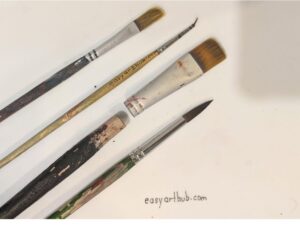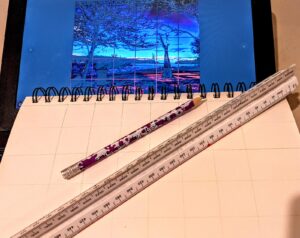Ready to start acrylic painting as a fun hobby? Look no further. This comprehensive guide will take you to the essential info to get you started. Let’s unleash your creativity and unlock the artist within!
We all know that acrylic is the best medium to start painting with. I know, I’m bias here. But they are great for beginners as they are versatile and can be budget friendly. If your itching to start painting, let’s dive in.
~This post contains affiliate links.
Budget for Acrylic Painting Hobby
When it comes to acrylic painting, there are a few things to consider. First off, you’ll need to think about the cost. As I explained in great detail here, acrylic painting hobby can fit various budgets. I recommend starting with basic student-grade materials which include acrylic paint, brush, and painting surface(eg. canvas or watercolor paper).
Materials for Acrylic Painting
Choosing the right acrylic paint
Choosing acrylic paint can be overwhelming. They come in different brands, qualities, and colors. Check out this post to help you decide what is the best acrylic paint for you and why.
Acrylic painting surface
Now, let’s talk about the surface you’ll be painting on. Acrylic paint can be applied to various surfaces like canvases, paper, and even rocks, and bags. You have lots of options to choose from, as I explained in this post.
Consider the texture and absorbency of the surface based on the outcome you’re aiming for. Make sure the surface is clean and free of dust or debris before you start. Some surfaces might require a primer or gesso layer to improve adhesion.
The amazing thing about acrylics is that they can be used on most surfaces if prepared properly. If you’re thinking of painting an unconventional surface (like fabric or glass) you may want to check this post first.
Brushes and other paint applicators
Moving on to brushes, another essential when it comes to acrylic painting. There are different shapes, sizes, and bristle types available, as you will learn in this post.
Luckily, they can come in a set that contains the basic brush you will need. While the post is meant for rock painting, the ideas there apply to all painting surfaces.
Think about the type of strokes you want to create and the scale of your artwork. Keep on learning and practicing. Don’t be afraid to experiment with different brushes to find what works best for you.
Oh, and remember to clean your brushes thoroughly after each painting session to keep them in good shape. This is important that I wrote an entire blog about how to take care of your brushes.
If you’re feeling adventurous, you can explore brush alternatives too. Palette knives, sponges, or even everyday objects can be used to create unique textures and effects in your paintings.
Miscellaneous Materials
Let’s talk about a few miscellaneous items. You will need a palette to mix and blend your colors, I still use yogurt lids. You can use a typical handheld palette, a disposable pad, a wet palette, or even a glass surface.
If you will paint large canvases or boards, consider getting an easel to provide stable and adjustable support for your painting. I don’t, since I don’t have much space and I just usually paint on small surfaces like mini canvas, cards, and rocks. Pick one that suits your workspace and preferences.
Drawing Before Painting
When starting a painting, you might want to sketch your initial design. While it’s not necessary, learning basic drawing skills can help you plan and execute your paintings more effectively. You can use pencils, charcoal, or even digital tools for sketching.
Do you need to sketch before painting? Not necessarily. I explain this in more detail here.
If drawing isn’t your forte, no worries! You can trace or transfer your desired image onto the canvas using transfer paper, a projector, or the grid method. For rock painting, I showed 11 ways to outline the design. They can be applied to any small painting surface as well.
Color Theory
Although a hobbyist can have fun with acrylic paint without learning color theory, I think learning it makes it more enjoyable. It allows you to create harmonious and visually appealing paintings. Get familiar with the color wheel, complementary colors, warm and cool tones, and color mixing techniques to expand your range of possibilities.
If you want to learn more about color theory, click here.

Acrylic Painting Techniques for Beginners
For beginners, blending and mixing are important techniques to practice. Acrylic paints can be blended and mixed in a lot of ways. In this post, I explored some basic techniques you can try.
Experimenting with different brush strokes can also add texture and interest to your paintings. Following tutorials is a fun and rewarding way to practice the techniques. I’m building a library of beginner-friendly tutorials with pictures (and videos soon) here.

Like with any skill, practice makes better. Have fun and don’t be afraid to make mistakes.
After Painting
After you’ve finished your painting, make sure to let it dry completely. Consider applying a varnish to protect and enhance the longevity of your artwork. Finally, display or store your finished piece appropriately to avoid damage or fading over time.
I hope these tips and suggestions will help you start your acrylic painting journey!



